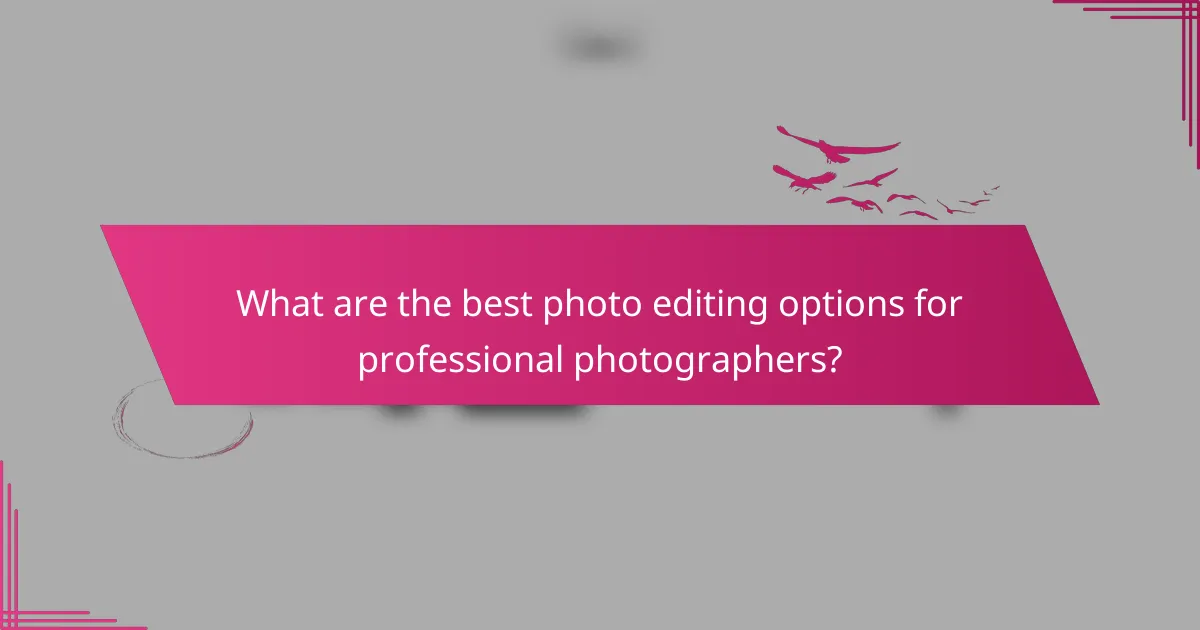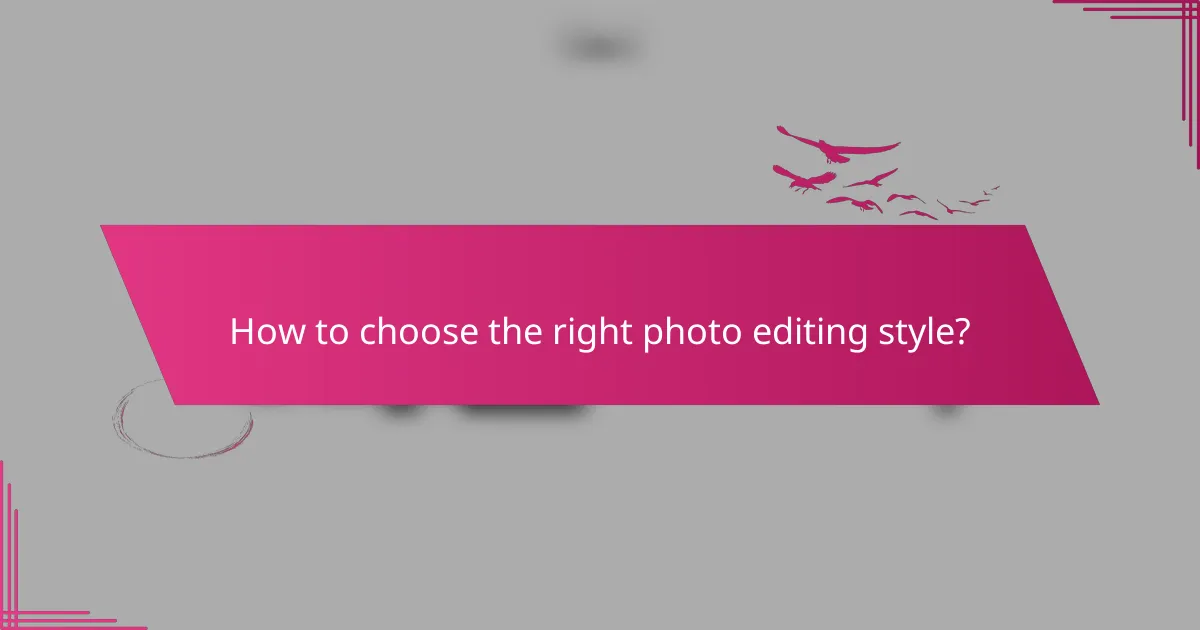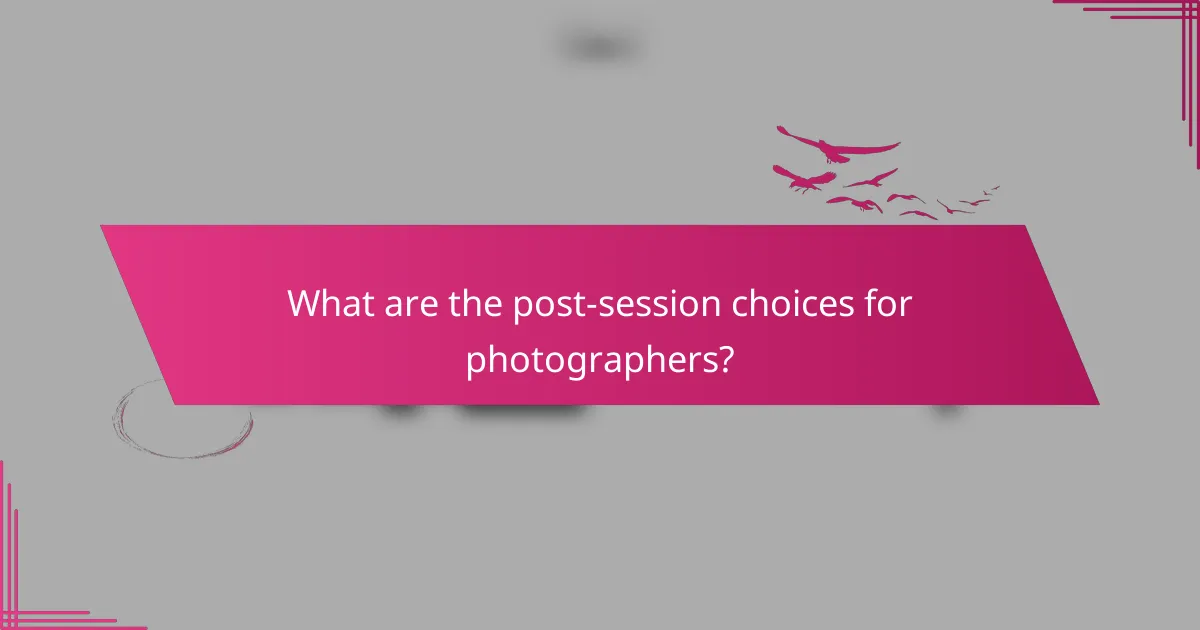Photo editing plays a crucial role in enhancing the quality and appeal of images, with various software options available to meet diverse needs. In 2023, popular editing styles range from minimalist to vintage, each offering distinct aesthetics that cater to different artistic visions. Choosing the right editing style is essential, as it influences audience perception and can significantly affect the overall message of your work.

What are the best photo editing options for professional photographers?
The best photo editing options for professional photographers include software that enhances image quality, provides advanced editing tools, and supports various file formats. Popular choices are Adobe Lightroom, Capture One, Affinity Photo, Photoshop, and GIMP, each offering unique features tailored to different editing needs.
Adobe Lightroom
Adobe Lightroom is widely regarded for its powerful organizational tools and non-destructive editing capabilities. It allows photographers to manage large collections of images efficiently while providing advanced features like presets and batch processing.
Lightroom is particularly effective for adjusting exposure, color balance, and applying filters. It is ideal for photographers who need to edit multiple images quickly, such as during events or weddings.
Capture One
Capture One is known for its exceptional color grading and tethering capabilities, making it a favorite among studio photographers. It offers advanced tools for precise adjustments and supports a wide range of camera formats.
This software is particularly beneficial for those who require high-quality RAW processing and detailed control over image attributes. Capture One’s customizable interface allows users to tailor their workspace to fit their workflow.
Affinity Photo
Affinity Photo is a cost-effective alternative to Adobe products, providing robust editing features without a subscription model. It supports advanced retouching, layer management, and a variety of filters.
This software is suitable for photographers who want professional-grade tools at a one-time purchase price. Affinity Photo is particularly effective for detailed image manipulation and creative compositions.
Photoshop
Photoshop remains the industry standard for photo editing due to its extensive capabilities and versatility. It offers advanced features like layer blending, masking, and a vast array of plugins.
While it has a steeper learning curve, Photoshop is essential for photographers who need to perform complex edits or create composite images. It is commonly used for both photo editing and graphic design.
GIMP
GIMP is a free, open-source photo editing software that provides a wide range of features comparable to paid options. It supports various file formats and offers tools for retouching, color correction, and image composition.
While GIMP may lack some advanced features found in premium software, it is a great choice for photographers on a budget or those just starting. Users should be prepared for a less intuitive interface but can benefit from a strong community and numerous plugins.

What styles of photo editing are popular in 2023?
In 2023, popular photo editing styles include minimalist editing, vintage styles, high dynamic range (HDR), black and white photography, and color grading. Each style offers unique aesthetics and techniques that cater to different artistic visions and preferences.
Minimalist editing
Minimalist editing focuses on simplicity and clarity, emphasizing the subject without unnecessary distractions. This style often involves reducing clutter, enhancing natural colors, and using negative space effectively. The goal is to create a clean, straightforward image that communicates the essence of the subject.
To achieve a minimalist look, consider using subtle adjustments in exposure and contrast while avoiding heavy filters. A good rule of thumb is to limit the number of elements in the frame and focus on the most important aspects of the photograph.
Vintage styles
Vintage styles evoke nostalgia by mimicking the look of old photographs, often characterized by faded colors, grainy textures, and soft focus. This style can be achieved through various techniques, including the use of filters, overlays, and specific color palettes that reflect past eras.
When editing for a vintage effect, consider using sepia tones or muted colors to create warmth. Additionally, adding grain can enhance the authenticity of the vintage look. Popular tools for achieving this style include presets and filters available in many editing software options.
High dynamic range (HDR)
High dynamic range (HDR) photography captures a wider range of light and detail in both shadows and highlights, resulting in vibrant and striking images. This technique typically involves taking multiple exposures of the same scene and merging them to create a single image with enhanced detail.
To effectively use HDR, ensure that your camera is stable during the shot to avoid ghosting effects. Post-processing software can help blend the exposures seamlessly, but be cautious of over-processing, which can lead to unnatural results. Aim for a balanced look that retains realism.
Black and white photography
Black and white photography emphasizes contrast, texture, and composition by removing color distractions. This style can convey strong emotions and timelessness, making it a popular choice for portraits and landscapes alike.
When converting to black and white, pay attention to the tonal range and adjust brightness and contrast to highlight key features. Experimenting with filters during the editing process can also enhance specific elements, such as clouds in a landscape or the details in a subject’s face.
Color grading
Color grading involves adjusting the colors in an image to create a specific mood or atmosphere. This technique is widely used in film and photography to enhance storytelling through visual cues. Color grading can range from subtle adjustments to dramatic shifts in hue and saturation.
To effectively color grade, start with a clear vision of the desired mood. Use tools within editing software to adjust color balance, saturation, and contrast. Be mindful of maintaining a cohesive look throughout your images, especially if they are part of a series or project.

How to choose the right photo editing style?
Selecting the right photo editing style involves understanding your audience, the subject matter, and current trends. This choice significantly impacts how your images are perceived and can enhance or detract from the intended message.
Consider your target audience
Your target audience plays a crucial role in determining the appropriate photo editing style. For instance, a youthful audience may respond better to vibrant, bold edits, while a more mature demographic might prefer subtle, classic styles.
Identify the preferences and expectations of your audience. Conducting surveys or analyzing engagement on social media can provide insights into what styles resonate best with them.
Assess the subject matter
The subject matter of your photos should guide your editing choices. For example, portraits often benefit from soft, flattering edits, while product photography may require sharp, high-contrast styles to highlight details.
Consider the emotions you want to evoke. Nature photography might call for a natural, earthy palette, while fashion photography could leverage high saturation and dramatic contrasts to create a striking visual impact.
Evaluate current trends
Staying updated on current photo editing trends is essential for maintaining relevance. Trends can shift rapidly, influenced by social media and popular culture, so regularly reviewing platforms like Instagram or Pinterest can help you stay informed.
Incorporate popular styles, such as minimalism or vintage aesthetics, but ensure they align with your brand identity. Avoid overusing trends that may quickly become outdated, as this can make your work feel less authentic.

What are the post-session choices for photographers?
Post-session choices for photographers include various methods for presenting and delivering images to clients. These options can significantly impact how clients perceive the final product and how they choose to share or display their photos.
Online galleries
Online galleries are a popular choice for photographers to showcase their work. They allow clients to view, select, and download images conveniently from any device. Many photographers use platforms like Pixieset or SmugMug, which offer customizable galleries and options for password protection.
When setting up an online gallery, consider the user experience. Ensure that the navigation is intuitive and that images load quickly. Providing options for clients to purchase prints directly from the gallery can also enhance the service.
Print options
Print options are essential for clients who wish to have physical copies of their photos. Photographers can offer a range of print sizes and finishes, from standard prints to high-quality canvas or metal prints. It’s important to communicate the differences in quality and pricing to clients.
Consider partnering with a professional printing service to ensure high-quality results. Offering packages that include prints along with digital files can be an attractive option for clients looking for comprehensive solutions.
Social media sharing
Social media sharing is a vital aspect of modern photography, allowing clients to easily share their images with friends and family. Photographers should provide clients with optimized images for social media platforms, ensuring they are the right dimensions and quality for posting.
Encourage clients to tag your business when they share images online. This not only promotes your work but also helps build your online presence. Providing a few social media-friendly images along with the full gallery can enhance client satisfaction.
Client delivery methods
Client delivery methods refer to how photographers provide final images to their clients. Common methods include USB drives, downloadable links, and online galleries. Each method has its pros and cons, such as convenience versus the tactile experience of a physical product.
When choosing a delivery method, consider the client’s preferences and the nature of the shoot. For instance, a wedding photographer might opt for a USB drive with a custom design, while a portrait photographer might prefer a simple online gallery. Always ensure that the delivery method is secure and user-friendly.

What are the benefits of using Adobe Lightroom for photo editing?
Adobe Lightroom offers numerous advantages for photo editing, including powerful tools for enhancing images while maintaining original quality. Its features cater to both amateur and professional photographers, making it a versatile choice for various editing needs.
Non-destructive editing
One of the key benefits of Adobe Lightroom is its non-destructive editing capability. This means any adjustments made to an image do not alter the original file, allowing you to revert to the unedited version at any time. This feature is particularly useful for photographers who want to experiment with different styles without the risk of losing their original work.
Lightroom saves edits as metadata, which means you can apply and remove changes without affecting the actual image file. This is advantageous for maintaining high-resolution files, especially when working with RAW formats that capture more detail.
Efficient workflow
Adobe Lightroom enhances workflow efficiency through its intuitive interface and organizational tools. Users can quickly import, categorize, and edit large batches of photos, streamlining the editing process significantly. This is especially beneficial for photographers handling multiple sessions or events.
The software also allows for the use of presets, which can apply a consistent look across numerous images with just a click. This saves time and ensures a cohesive style, making it easier to manage projects with tight deadlines.
